CEAI, Vol.14, No.4, pp. 42-49, 2012 Printed in Romania
Model Free Adaptive Control with Disturbance Observer
Bu Xuhui*, Hou Zhongsheng**, Yu Fashan*, Fu Ziyi
* School of Electrical Engineering & Automation , Henan Polytechnic University
Jiaozuo, China. (Tel: 0391-3987597; e-mail: buxuhui@ gmail.com)., ,
** Advanced Control Systems Lab., Beijing Jiaotong University,
Beijing, China (e-mail: zhshhou@bjtu.edu.cn)
Abstract: This paper considers the problem of model free adaptive control (MFAC) for nonlinear
systems subject to disturbances. It is shown that the robust stability of MFAC systems with disturbances
can be guaranteed, and the bound on tracking error depends on the bound on the disturbance. To
attenuate disturbance, an improved MFAC is also developed using disturbance observer based control
techniques, where the disturbance observer design is established by radial basis function (RBF) neural
network. The stability analysis of proposed MFAC algorithm is given, and the effectiveness is also
illustrated by simulations.
Keywords: Model free adaptive control, disturbance observer, RBF neural network, robustness
1. INTRODUCTION
Model free adaptive control (MFAC) is an attractive
technique which has gained a large amount of interest in the
recent years (Hou et al. 1997). The key feature of this
technique is to design controller only using the I/O data of
the controlled system, and can realize the adaptive control
both in parametric and structural manner (Hou et al. 2006,
2011a, 2011b). Instead of identifying a, more or less, known
global nonlinear model of the plant, a series of equivalent
dynamical linearized time varying models is built along the
dynamic operation points of the controlled plant using a
novel concept called pseudo-partial derivative (PPD), which
is estimated merely using the I/O data of the controlled plant.
Since the model is valid only for a small domain around the
operation point, the PPD estimation algorithm has to be
repeated at each time instant. Based on the equivalent
dynamical linearized model, the analysis and design for the
MAFC scheme
implemented. The dynamic
linearization method includes the compacted form dynamic
linearization (CFDL), partial form dynamic linearization
(PFDL), and full form dynamic linearization (FFDL). Up to
now, this technique has been extensively studied with
significant progress
theoretical aspects and
applications (Hou et al. 2011c; Tan et al. 2001; Leandro et al.
2009, 2010; Chi et al. 2008; Zhang et al. 2006; Bu et al. 2009,
2010).
Almost all engineering control systems, the presence of
disturbances is inevitable. For example, when the robot
manipulators grasp an unknown payload, they are affected by
unknown inertia variation and gravity force, but these
changes are rarely captured in the models. It is most desirable
that the controller be insensitive to these uncertainties.
Hence, in recent years, the problem of controlling uncertain
dynamical systems subject to external disturbances has been
a topic of considerable interest. To the best of our knowledge,
then be
in both
then
is first discussed, and
no one has been discussed the MFAC with external
disturbance. This motivated the present study. This paper
considers the problem of MFAC for the nonlinear system
with external disturbance. The influence of disturbance for
the MFAC systems
the
disturbance attenuation is also considered.
In the literature, an effective technique to enhance the
performance of systems in the presence of disturbances is the
application of disturbance observers. Disturbance observers
are useful tools that are originally proposed in (Ohnishi et al
1987a, 1987b) as means of estimating disturbances to linear
systems and canceling them subsequently. Later, researchers
advanced the theory of disturbance observers (Kemf et al.
1999). Presently, disturbance observers are successfully used
in achieving robust stability and performance in motion
control systems, for instance, in controlling robotics systems,
high-speed machining systems, disk drives (Huang et al.
1998; Ishikawa et al. 1998; Komada et al. 2000; Yang et al.
2008). Recent work has been concentrated on
the
development of nonlinear disturbance observers. To this end,
Oh et al (1999) first improved a linear disturbance observer
in robots using the information of nonlinear inertial coupling
dynamics. The application of this modified observer in
redundant manipulators gives improved performance. A
sliding mode based nonlinear disturbance observer was
proposed and applied in motor control by (Chen et al 2000a).
(Chen et al 2000b) developed a nonlinear disturbance
observer for unknown constant using Lyapunov theory and
applied it to a two-link manipulator.
However, the aforementioned linear disturbance observers or
nonlinear disturbance observers are all model based
disturbance observers, and these observers are designed
based on the model information of the controlled systems.
MFAC is a model free control approach, which is proposed
for the nonlinear system with unknown model information.
Hence the model based disturbance observers cannot be
�
CONTROL ENGINEERING AND APPLIED INFORMATICS
applied to disturbance attenuation for MFAC approach. In
this paper, a disturbance observer based on Radial Basis
Function (RBF) neural network is introduced to enhance the
disturbance attenuation ability of MFAC algorithm. RBF
neural network is introduced RBF into a two layer neural
network, where each hidden unit implements a radial
activated function. The output units implement a weighted
sum of hidden unit outputs, and the input into an RBF
network is nonlinear while the output is linear. Thus, it has
excellent approximation capabilities
to any nonlinear
function. The rest of this paper is organized as follows. In
Section 2, the control algorithm of MFAC is reviewed, and
the MFAC system with disturbances is formulated. In Section
3, the robust stability of such a MFAC system is analyzed. In
section 4, an improved algorithm of MFAC with disturbance
observer is proposed, and the stability is also given. A
numerical example is given in section 5. Conclusions are
given in Section 6.
2. PROBLEM FORMULATIONS
Considering the following discrete-time SISO nonlinear
system
y k
1)
(
f y k
( ( ),
y k n
(
u k
), ( ),
(1)
u k n
, (
u
)),
,
y
43
pseudo-partial-derivative (PPD), such that if
system (1) can be described as the following CFDL model
y k
(
(2)
, the
1)
u k
( ),
k
( )
u k
( )
0
and
.
( )k
b
0
0
u k
( )
u k
( )
( )u k
and
The proof of Theorem 1 can be founded in (Hou et al 2011a).
Remark 2: Eq.(2) is a dynamic linear system with slowly
is not too
time-varying parameter if
large. Therefore, when it is used for the control system
design, the condition
and not too large altitude of
( )u k
should be guaranteed. In other words, some free
adjustable parameter should be added in the control input
criterion function to keep the change rate of control input
signal not too large.
Rewritten (2) as
y k
(
(3)
For the control algorithm, a weighted one-step- ahead control
input cost function is adopted, and given by
1)
u k
( ).
y k
( )
k
( )
J u k
( ( ))
y k
(
*
1)
y k
(
1)
2
u k
( )
u k
(
1)
2
,
(4)
u
)
)
u k
( )
u k
( )
that
u k
( )
with
1)
and b is a
n n are the unknown orders of output
,y
( )u k respectively,
y k and
( )
f is an unknown nonlinear
(
is generalized Lipschitz,
0
for any k and
u k
(
where
input
function.
The following assumptions are made for the controlled plant.
f with respect to control
(
A1: the partial derivative of
( )u k is continuous.
input
A2:
system
the
(1)
y k
b u k
( )
1)
(
is,
y k
y k
y k
( ),
(
(
1)
1)
positive constant.
Remark 1: These assumptions of the system are reasonable
and acceptable from a practical viewpoint. Assumption A1 is
a typical condition of control system design for general
nonlinear system. Assumption A2 poses a limitation on the
rate of change of the system output permissible before the
control algorithm to be formulated is applicable. From the
‘energy’ point of view, the energy rate increasing inside a
system cannot go to infinite if the energy rate of change of
input is in a finite altitude. For instance, in a water tank
control system, since the change of the pump flow of water
tank is bounded, the liquid level change of the tank caused by
the pump flow cannot go to infinity. There exist a maximum
ratio factor between the liquid level and the pump flow, just
as the positive constant b defined in Assumption A2.
The following theorem illustrates that the general discrete
time nonlinear system satisfying assumptions A1-A2 can be
transformed into an equivalent dynamical form linearization
model, called CFDL model.
Theorem 1: For
assumptions A1 and A2, then there must exist a
the nonlinear system (1) satisfying
( )k , called
y k is the expected system output signal, and
*(
1)
where
is a positive weighted constant.
Substituting (3) into (4), solving the equation
gives the control algorithm as follows:
u k
( )
1)
1)
y k
(
*
u k
(
k
( )
k
( )
2
y k
( ) ,
J u k
( ( ))
u k
( )
0
where is the step factor.
Theorem 1 shows that the nonlinear system (1) satisfying A.1
and A.2 can be described by the dynamic linearization model
(2) with PPD ( )k . It is obvious that many parameter
estimation algorithms such as least-squares algorithm and
improved algorithm, gradient algorithm and
improved
algorithm, can be adopted to estimate PPD.
The objective function for parameter estimation is used as
J
( ( ))
1)
u k
(
k
( )
1)
k
2
y k
( )
y k
(
ˆ
(
k
( )
2
.
k
1)
Using the similar procedure of control algorithm equations,
the parameter estimation algorithm can be obtained as
follows:
ˆ
ˆ
(
1)
1)
y k
( )
u k
(
ˆ
(
k
( )
k
k
u k
1)
(
u k
(
1)
2
1) .
k
( )
Summarizing, the MFAC algorithms based on CFDL model
is given as follows:
ˆ
ˆ
k
1)
(
u k
(
1)
u k
(
1)
(5)
y k
( )
1)
1)]),
u k
(
ˆ
(
k
[
2
�
44
CONTROL ENGINEERING AND APPLIED INFORMATICS
k
( )
,
ˆ( )
k
ˆ( )
k
ˆ
ˆ
k
( )
(1),
if
ˆ
or u k
(
1)
,
(6)
u k
( )
u k
(
1)
[
y k
(
*
1)
y k
( )],
2
(7)
, are the step-size and they are usually set as
, are weight factors, is a small positive
(0,1)
where
,
constant, ˆ(1) is the initial value of ˆ( )k .
.
0
u k
( )
Remark 3: In order to make the condition
in
theorem 1 be satisfied, and meanwhile to make the parameter
estimation algorithm have stronger ability in tracking time-
varying parameter, a reset algorithm has been added into this
MFAC scheme as (6).
Remark 4: The control algorithm (7) has no relationship with
any structural
information (mathematical model, order,
structure, etc) of the controlled plant. It is designed only
using input and output data of the plant.
Almost all engineering control systems, the presence of
disturbances is inevitable. In this case, the nonlinear system
(1) can be described as
y k
y k n
(
(
u k n
d k
))
1)
( ),
, (
u
b 。
d k
( )d k is a bounded disturbance with
( )
f y k
( ( ),
where
), ( ),
u k
,
y
d
(8)
3. ROBUST STABILITY ANALYSIS
0
0
0
b
1
b
1
b
1
k
( )
k
( )
( or
in this paper.
In order to obtain robust stability of the MFAC algorithm,
another assumption about the controlled system should be
made.
k
), 1b
( )
A3: The PPD satisfies
is a positive constant. Without loss of generality, it is
assumed that
Remark 5: Most of plants in practice can satisfy this
condition, its practical meaning is obvious, that is, the plant
output should increase (or decrease) when the corresponding
control input increase. For example, the water tanks control
system, the temperature control system, and so on.
Theorem 2: For
Assumptions Al, A2, then the system can be described as
y k
(
the nonlinear system (8) satisfying
(9)
u k
( )
1)
d k
( ),
k
( )
1).
d k
(
d k
( )
d k
( )
where
Proof: From Eq.(8), the following equation can be obtained
y k
1)
(
f y k
( ),
f y k
1),
(
f y k
( ),
f y k
(
1),
f y k
(
1),
f y k
1),
(
d k
u k n
, (
( )
)
u
u k
u k n
1), (
, (
1),
u
u k n
)
, (
u
u k
u k
1), (
1), (
u k
u k
1), (
1), (
u k
1), (
1),
y k n u k
, (
), ( ),
y
y k n
, (
y
y k n u k
, (
), ( ),
y
y k n
, (
y
y k n
, (
y
y k n
, (
y
u k n
, (
u
u k n
, (
u
1)
1),
1)
,
u k n
, (
u
1)
1)
d k
( ).
d k
(
1)
1)
Using assumption A2 and the mean value theorem, (10) gives
y k
(
1)
f
u k
( )
u k
( )
k
( )
d k
( ),
where
f
u k
( )
denotes the value of gradient vector of
f
(
)
with respect to
( )u k , and
k
( )
f y k
(
f y k
(
y k n
, (
1),
y
y k n
1),
, (
u k
1), (
u k
1), (
u k
1), (
1),
y
1),
u k n
, (
u
u k n
, (
u
1) .
1)
Considering the following equation
u k
( ),
k
( )
k
( )
(11)
( )k is a variable. Since the condition
u k
( )
, (11)
0
where
must have a solution
( )k . Let
k
( )
f
u k
( )
k
( ),
then (10) can be written as
y k
(
u k
( )
1)
k
( )
d k
( )
.
To prove our main result, the following lemmas are
developed first.
Lemma 1: For the nonlinear system (8) with Assumptions Al,
, are
A2, A3, and using the MFAC algorithms (5)-(7), if
0,
, then the PPD estimated value
chosen as
ˆ( )k is bounded.
(0,1)
Proof: When
obtained by the reset algorithm (6).
u k
(
,
1)
the bound of ˆ( )k can be
1)
u k
(
, let
When
k
( )
parameter estimation algorithm becomes
k
( )
k
( )
k
( )
ˆ
k
( )
, then the
Note that
k
( )
(1
k
(
y k
( )
2
(
1)
u k
1)
(
u k
(
1)
y k
k
(
( )
1)
u k
1)
(
2
u k
(
1)
2
u k
1)
(
u k
(
2
d k
(
1)
2
ˆ
(
k
1)
u k
(
(12)
,
1))
u k
(
) (
k
1)
d k
(
1)
, then
1)
(13)
1)
k
( ).
From (13), it is obvious that
1
k
( )
(
k
1)
2
u k
1)
(
2
u k
(
1)
2
u k
1)
(
u k
(
1)
2
u k
(
1)
2
u k
(
1)
2
1
d k
(
(10)
1)
k
( )
(
k
1)
2
u k
(
u k
(
2
1)
1)
b
2
d
b
2
(14)
�
CONTROL ENGINEERING AND APPLIED INFORMATICS
45
Since
0 and
(0,1)
, then
*
y
y k
(
1)
*
y
y k
( )
k
( )
u k
( )
d k
( ),
(19)
u k
(
2
1)
u k
(
2
1)
u k
(
2
1),
Substituting (19) into (18), the following can be obtain
e k
(
(20)
(1
1)
k e k
( )) ( )
d k
( ),
1)
1)
1.
2
then
e k
(
1)
(1
k
( ))
e k
( )
d k
( ) .
(21)
which leads to
u k
(
2
u k
(
0
Note
u k
(
u k
(
2
1)
1)
u k
(
u k
(
2
1)
1)
u k
(
1)
u k
(
1)
(15)
2
.
then
k
( )
(1
(
)
k
1)
db
b
2 .
Since
0,
(0,1)
and
d
2
. Hence
1
2
)
b
(
4
, then
0
k
( )
d
1
2
d e k
( )
)
1
d
e k
(
)
1
e
d
(1)
)
1
)
(1
k
1
b
2
d
1)
(1
(1
k
d
1
d
1
) 1 ,
d
1
b
)2
d
b
2
d
(22)
1)
e k
(
(1
(1
(1
b
2
d
which leads to
b
2
e k
lim ( )
.d
d
k
1
Remark 6: Theorem 3 illustrates the influence of the
disturbance. Although the system output is still stability, the
tracking error not converges to 0 but a positive constant. The
bound on tracking error depends on the bound on the
disturbance. If the disturbances tend to 0, then the tracking
error also tends to 0.
k
2)
c
(1
c
(16)
Hence
k
( )
(1
(1
)
k
(
(
)
2
1)
c
(1
1
)
k
(1)
where
c
db
b
2
.
)
c
1 (1
,
)
1 , thus
As 0 1
bounded, then ˆ( )k is bounded.
( )k
is bounded. Since
( )k is
dy
( )u k
( )d k
( )y k
Lemma 2: Define
k
( )
ˆ( ) ( )
k
k
ˆ ( )
k
2
, if
, are chosen as
ˆ( )
d k
2
)
then
it exists constants
,d d
1
2
such
that
b
(
4
0
d
k
( )
d
1
1.
2
The proof of Lemma 2 can be founded in (Hou et al 2011c).
With the above lemmas, the following result can be given.
Theorem 3: For the nonlinear system (8) with Assumptions
Al, A2, A3, and using the MFAC algorithms (5)-(7), when
y k
( )
*
,
0,
const
(0,1)
y
*
and
, satisfy
, then the system tracking error
, are chosen as
, if
b
(
)
4
2
satisfies
e k
lim ( )
k
where
b
2
,d
d
1
y k
( )
*
e k
( )
y k
( )
.
(17)
Proof: From (7), one has
ˆ( )
k
ˆ ( )
k
2
1)
u k
( )
u k
(
e k
( ).
(18)
Theorem 2 gives
Fig. 1. The configuration of MFAC with disturbances
observer.
4. MFAC WITH DISTURBANCE OBSERVERS
4.1 The improved MFAC algorithm
In this section, a robust MFAC for disturbance attenuation is
proposed. The design procedure for disturbance attenuation is
given in the following procedure:
1) Design a disturbance observer to estimate the disturbance.
2) Integrate the disturbance observer with the controller by
replacing the disturbance in the MFAC algorithm with its
estimation yielded by the disturbance observer.
From Theorem 3, the nonlinear system (8) with disturbance
can be described as
y k
u k
( )
(
(23)
1)
d k
( ).
k
( )
�
46
CONTROL ENGINEERING AND APPLIED INFORMATICS
Substituting control algorithm (7) into (23) gives
y k
(
1)
y k
( )
k
( )
ˆ( )
k
ˆ( )
k
2
*
y
y k
( )
d k
( ).
(24)
d k
in the right of the Eq.(24), which
Note that the term ( )
d k . As shown in Fig.1, if the
results from the disturbance
( )
disturbance can be estimated, the control low with the
disturbance estimated value can be designed to compensate
the influence of the disturbances. Therefore, the following
improved control algorithm can be given:
u k
( )
y k
(
*
1)
y k
( )
ˆ
d k
( )
ˆ
k
( )
,
(25)
where
is the estimated valued of
d k
( )
.
Theorem 4: For the nonlinear system (8) with Assumptions
Al, A2, A3, and using the MFAC algorithms (5), (6), (25),
, are chosen as
when
const
y k
( )
*
if
,
y
*
0,
(0,1)
, and
, satisfy
2
)
, then the
b
(
4
system tracking error is bounded convergence, and the
.
bounded depended on the error between
ˆ( )
d k
d k
( )
and
Proof: Substitute the control algorithm (25) into (23), that is
y k
(
1)
d k
( )
y k
( )
k
( )
u k
(
1)
ˆ( )
k
ˆ
k
( )
ˆ( )
d k
2
u k
( )
ˆ( )
k
ˆ
k
( )
y k
( )
k
( )
d k
( )
2
*
y
y k
( )
ˆ
d k
( )
ˆ
k
( )
(26)
y k
( )
k
( )
*
y
y k
( )
k
( )
ˆ( )
k
ˆ
d k
( )
d k
( ),
subtracting
*y in both sides of (26) gives
e k
(
1)
1
k
( )
k
( ),
ˆ
k
Since
( ),
positive constant
e k
( )
k
( )
ˆ( )
k
ˆ( ),
d k
d k
( )
1 satisfying
ˆ
d k
( )
d k
( ) .
(27)
are bounded, it exists a small
(28)
,
1
d k
( )
ˆ( )
d k
k
( )
ˆ( )
k
From Lemma 2, (27) and (28), it is obvious that
e k
1)
(
d e k
( )
)
(1
1
e k
d
(
)
(1
1
e
d
)
(1)
(1
1
d
(1
)
1
1
1
d
)
(1
k
1
1
1
1
1)
(1
)
,
1
1
d
1
2
k
which leads to
(29)
e k
lim ( )
k
1
d
1
.
(30)
Hence, the system tracking error is bounded convergence.
1 , which is
The bounded on tracking error depends on
d k
determined by the error between
( )
ˆ( )
d k
and
.
Remark 7: It is shown that the tracking error of the system is
convergence when the disturbance estimated algorithm is
introduced into the MFAC algorithm. The smaller tracking
error can be obtained when
1 is smaller. From (28), one
knows that
1 is determined by the estimated algorithm. In
the following, the disturbance observer by RBF neural
network is given.
u k
(
2)
u k
(
1)
y k
( )
y k
(
1)
1l
2l
ml
1
2
j
ˆ( )d k
Fig. 2. The structure of RBF neural network disturbance
observer.
4.2 Disturbance observer based on RBF neural network
In this paper, a disturbance observer based on radial basis
function (RBF) neural network for estimating disturbance
d k
is introduced. As shown in Fig. 2, RBF networks have
( )
three layers: an input layer, a hidden layer with a non-linear
RBF activation function and a linear output layer. The
number of neurons in input layer, hidden layer and output
layer are 4, m and 1 respectively. The input vector of neural
network is
X
y k
( ),
1),
1),
y k
(
2)] ,T
[
u k
(
u k
(
and the radial basis vector is
Gauss basis function with
L
l
[ ,
1
l
2
,
,
l
m
]T
, where
jl is
l
j
exp(
2
),
j
X c
q
2
2
j
j
m
1,2,
.
The centre vector of j -th node is
c
j
[
c
,
c
j
1
j
2
,
,
c
jm
].
It is assumed that the basis width vector is
Q q q
,
2
[
1
,
,
q
m
] ,T
�
CONTROL ENGINEERING AND APPLIED INFORMATICS
where
jb is the basis width parameter of j -th node.
The weight vector of network is given as
W
m
[
,
,
,
1
2
] ,T
then, the output of the RBF neural network is
ˆ( )
d k
l
2 2
l
1 1
l
m m
.
Considering the following index
J
1
2 k
(
d k
( )
ˆ
d k
( )) ,
2
using the gradient descent approach, the following update
algorithms can be obtained:
j
j
1
k
( )
q
[
(
j
[
c
[
c k
( )
ji
q k
( )
j
j
q k
(
j
k
j
d k
( )
1)
[
1
k
k
2)]
(
1)
(
j
ˆ
d k l
( )]
j
d k
( )
ˆ
d k
( )]
l
j
q
1)
[
1
x
1
j
ˆ
d k
( )]
j
d k
( )
2
j
j
X c
q
3
j
q k
(
j
c
q
2
j
c k
[
(
ji
1
ji
j
c k
(
ji
1)
1
c
ji
1)
c k
(
ji
2)]
,
(31)
q k
(
j
2)]
1)
1 is learning rate, and
1 is momentum factor. It is
where
worth pointing out that the training of RBF network needs
some sampling data.
5. SIMULATIONS
In this example, the following SISO nonlinear system is
considered
y k
(
y k
1) (
1
y k
(
u k
2) (
1)
2
1)
y k
(
y k
(
2) 1
2)
2
u k
( )
d k
( ),
(32)
1)
y k y k
( ) (
d k is the external disturbance and it is unknown.
( )
where
The desired output is
y k
(
round k
(
*
1)
( 0.5)
/200)
,0
k
1000.
0
Firstly, it is assumed that there is no disturbances (i.e.
d k
) and the MFAC algorithms (5)-(7) is used to
( )
control the nonlinear system (32). The initial conditions are
given as
the
resetting initial value of PPD is 0.5, and the controller
. The
parameters are chosen as
simulation results are shown in Fig. 3. It is observed that
ˆ(1: 2)
(1: 2)
(1: 2)
510 ,
2
0,
2,
1,
1,
1,
u
1
y
47
satisfactory performance can be achieved by MFAC with the
given controller parameters in the absence of disturbance.
Suppose that there is disturbance acting on output of the
system, given by
d k
( )
0.15cos(k /30).
1
0.1
0.1,
1
As is shown in Fig. 4 by the dotted lines, the output
performance of the system is significantly degraded due to
the effect of disturbance. Then, the RBF neural network
disturbance observer is designed by the procedure presenting
in Section 4. The number of hidden layer’s node of RBF
neural network is chosen as 4, and
. The
above designed disturbance observer is then integrated with
the MFAC, and the simulation result is shown in Fig. 4 by the
solid lines. It is obvious that the MFAC with disturbance
observer can improve the output performance significantly,
and it achieves good disturbance attenuation ability. To
further validate the effective, tracking errors for MFAC and
MFAC with disturbance observer are also given in Fig. 5. For
MFAC scheme, there is tracking error caused by the
disturbance. However, the tracking error can be reduced
effectively by disturbance observer, and then better tracking
performance can be achieved.
0.8
0.6
0.4
0.2
)
k
(
y
0
-0.2
-0.4
-0.6
-0.8
0
y*(k)
MFAC
100
200
300
400
500
time(k)
600
700
800
900
1000
Fig. 3. The system output for MFAC in absence of
disturbance.
1
0.8
0.6
0.4
)
k
(
y
0.2
0
-0.2
-0.4
-0.6
0
y*(k)
MFAC with disturbance observer
MFAC
100
200
300
400
500
600
700
800
900
1000
time (k)
Fig. 4 The system output for different control algorithms in
presence of disturbance.
�
CONTROL ENGINEERING AND APPLIED INFORMATICS
48
5. CONCLUSIONS
In this paper, the robustness of MFAC system with
disturbances is considered. It is shown that the stability of
MFAC algorithm can be guaranteed when the system
subjects to disturbance, and the bound on tracking error
depends on the bound on the disturbance. Then, a general
framework for design of MFAC with disturbance observer
using RBF network neural technique is proposed. The
theoretical convergence of the tracking error has been
analyzed for the improved MFAC algorithms and the result is
also supported by simulations. RBF network neural can
estimated the disturbance only using the input and output
data, and
the
disturbances effectively.
then can compensate
influence of
the
MFAC with disturbance observer
MFAC
0.9
0.8
0.7
0.6
0.5
0.4
0.3
0.2
0.1
|
)
k
(
e
|
0
0
100
200
300
400
500
time(k)
600
700
800
900
1000
Fig. 5 The tracking error for different control algorithms in
presence of disturbance.
6. ACKNOWLEDGEMENTS
This work was supported by the National Science Foundation
of China (61203065, 61120106009), the program of Natural
Science of Henan Provincial Education Department
(12A510013), the program of Open Laboratory Foundation
of Control Engineering Key Discipline of Henan Provincial
High Education (KG 2011-10).
REFERENCES
Bu X. H, Hou Z. S., Jin S. T. (2009). The robustness of
model-free adaptive control with disturbance suppression.
Control Theory & Applications, vol. 26, no. 5, pp. 505-
509
Bu X. H., Hou Z. S. (2010). The robust stability of model
free adaptive control with data dropouts. The 8th IEEE
International Conference on Control and Automation,
Asia Gulf Hotel, Xiamen, China, pp. 1606-1611
Chen W. H., Ballance D. J., Gawthrop P. J., Reilly J. O.
(2000b). A nonlinear disturbance observer for two-link
robotic manipulators. IEEE Trans. Ind. Electron., vol. 47,
no. 8, pp. 932-938.
of
Chen X., Komada S., Fukuda T. (2000a). Design of a
Ind.
nonlinear disturbance observer.
Electron., vol. 47, no. 4, pp. 429-436
IEEE Trans.
Chi R. H., Hou Z. S. (2008). A model-free adaptive control
approach for freeway traffic density via ramp metering.
International
Innovative Computing,
Information and Control, vol. 4, no. 6, pp. 2823-283
Journal
Hou Z. S. (2006). On model-free adaptive control: the state
the art and perspective. Control Theory &
of
Applications, vol. 23, no. 4, pp. 586-592
Hou Z. S., Bu X. H. (2011c). Model Free Adaptive Control
with Data Dropouts, Expert Systems with Applications,
vol. 38, no. 8, pp. 10709-10717
Hou Z. S., Huang W. H. (1997). The model-free learning
adaptive control of a class of SISO nonlinear systems. In:
Proceedings of the American control conference, New
Mexico, USA, IEEE, pp.343-344
Hou Z. S., Jin S. T. (2011a). A Novel Data-Driven Control
Approach for a Class of Discrete-Time Nonlinear
IEEE Transactions on Control Systems
Systems,
Technology, vol. 19, no. 6, pp.1549-1558
Hou Z. S., Jin S. T. (2011b). Data-Driven Model-Free
Adaptive Control for a Class of MIMO Nonlinear
Discrete-Time Systems. IEEE Transactions on Neural
Networks. vol. 22, no. 12, pp. 2173 - 2188
Huang Y. H., Messner W. (1998). A novel disturbance
observer design for magnetic hard drive servo system
with rotary actuator. IEEE Trans. Magn., vol. 4, no. 6, pp.
1892-1894
Ishikawa
J., Tomizuka M.
friction
compensation using an accelerometer and a disturbance
observer for hard disk. IEEE/ASME Trans. Mechatron.,
vol. 3, no. 9, pp. 194-201
(1998). Pivot
Kemf C. J., Kobayashi S. (1999). Disturbance observer and
feedforward design
for a high-speed direct-drive
positioning table. IEEE Trans. Contr. Syst. Technol., vol.
7, no. 9, pp. 513-526
Komada S., Machii N., Fukuda T. (2000). Control of
redundant manipulators considering order of disturbance
observer. IEEE Trans. Ind. Electron., vol. 47, no. 2, pp.
413-420
Leandro S. C., Antonio A. R. C. (2009). Model-free adaptive
control optimization using a chaotic particle swarm
approach,Chaos, Solitons and Fractals, vol. 41, no. 4,
pp. 2001-2009.
Leandro S. C., Marcelo W. P., Sumar R. R., Antonio A. R. C.
(2010). Model-free adaptive control design using
evolutionary- neural compensator, Expert Systems with
Applications, vol. 37, no. 1, pp. 499-508.
Oh Y., Chung W. K. (1999). Disturbance-observer-based
motion control of redundant manipulators using inertially
decoupled dynamics. IEEE/ASME Trans. Mechatron., vol.
4, no. 12, pp. 133-145.
Ohishi K., Nakao M., Ohnishi K., Miyachi K. (1987b).
Microprocessor controlled DC motor for load-insensitive
position servo system. IEEE Trans. Ind. Electron., vol. 34,
no. 1, pp. 44-49
�
CONTROL ENGINEERING AND APPLIED INFORMATICS
49
Ohnishi K. (1987a). A new servo method in mechatronics.
Trans. Jpn. Soc. Elect. Eng., vol. 107, no. D, pp. 83-86
Tan K. K., Lee T. H., Huang S. N., et al. (2001). Adaptive-
Predictive control of a class of SISO nonlinear systems.
Dynamics and Control, vol. 11, no. 2, pp. 151-174
Yang Z. J., Tsubakihara H., Kanae S., Wada K., Su C. Y.
(2008). A novel robust nonlinear motion controller with
disturbance observer. IEEE Trans. Control Syst. Technol.
vol. 16, no. 1, pp. 137–147
Zhang B., Zhang W. D. (2006). Adaptive predictive
functional control of a class of nonlinear systems, ISA
Trans., vol. 45, no. 2, pp. 175-83
�
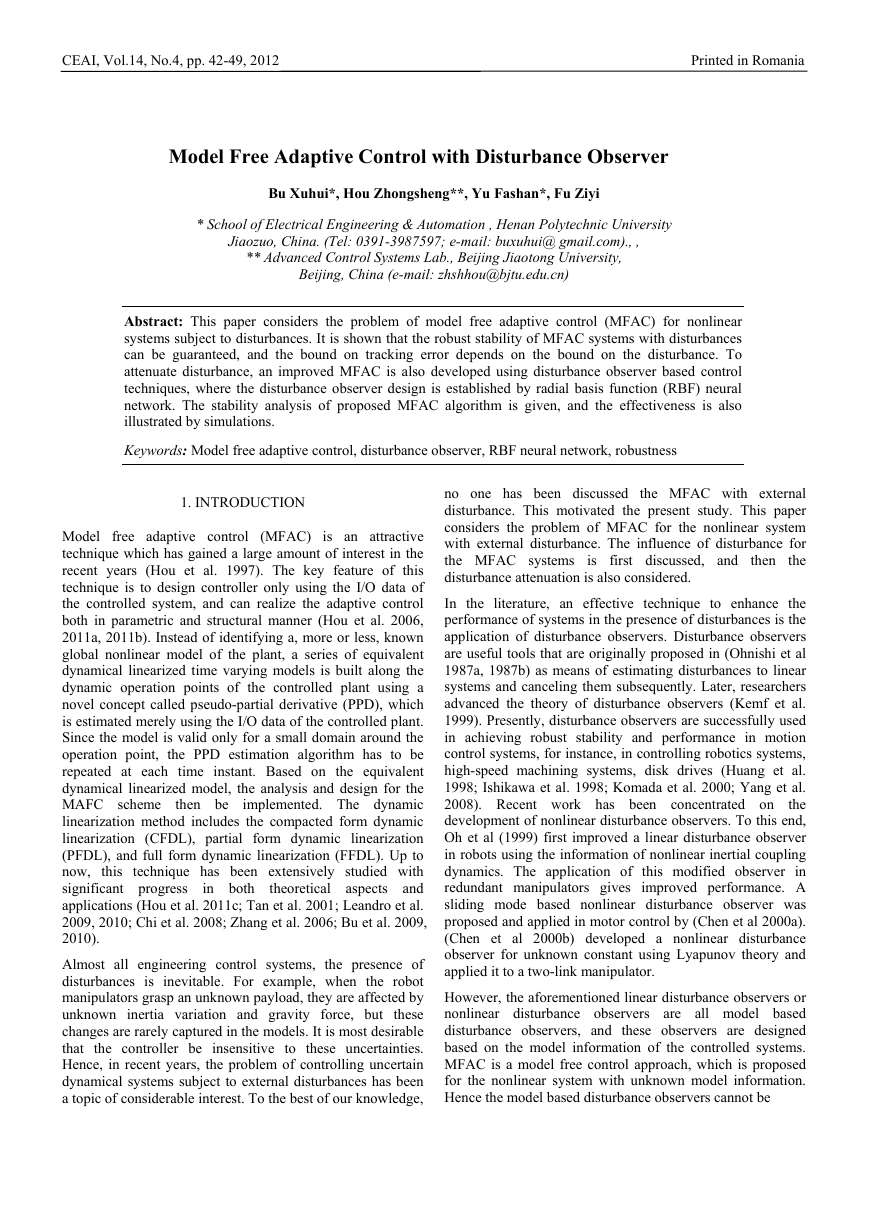
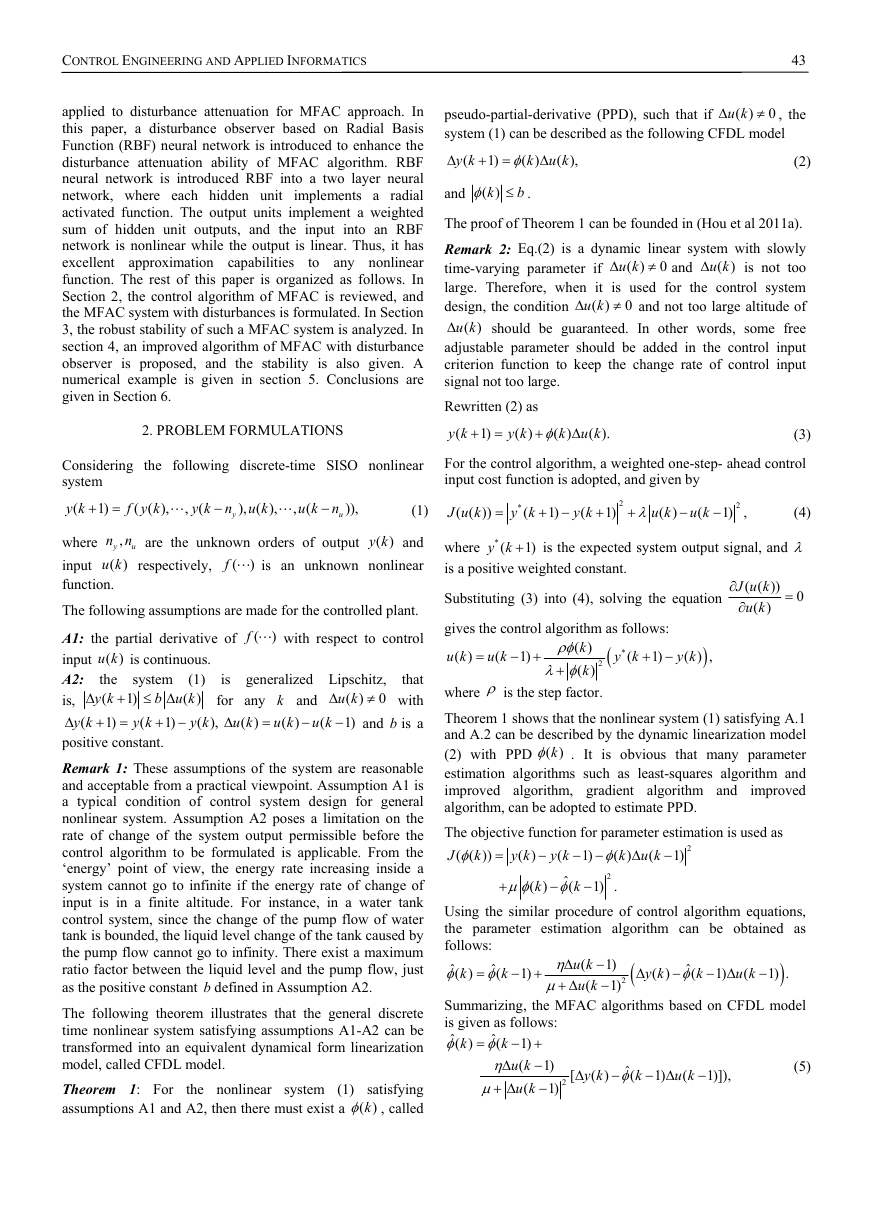

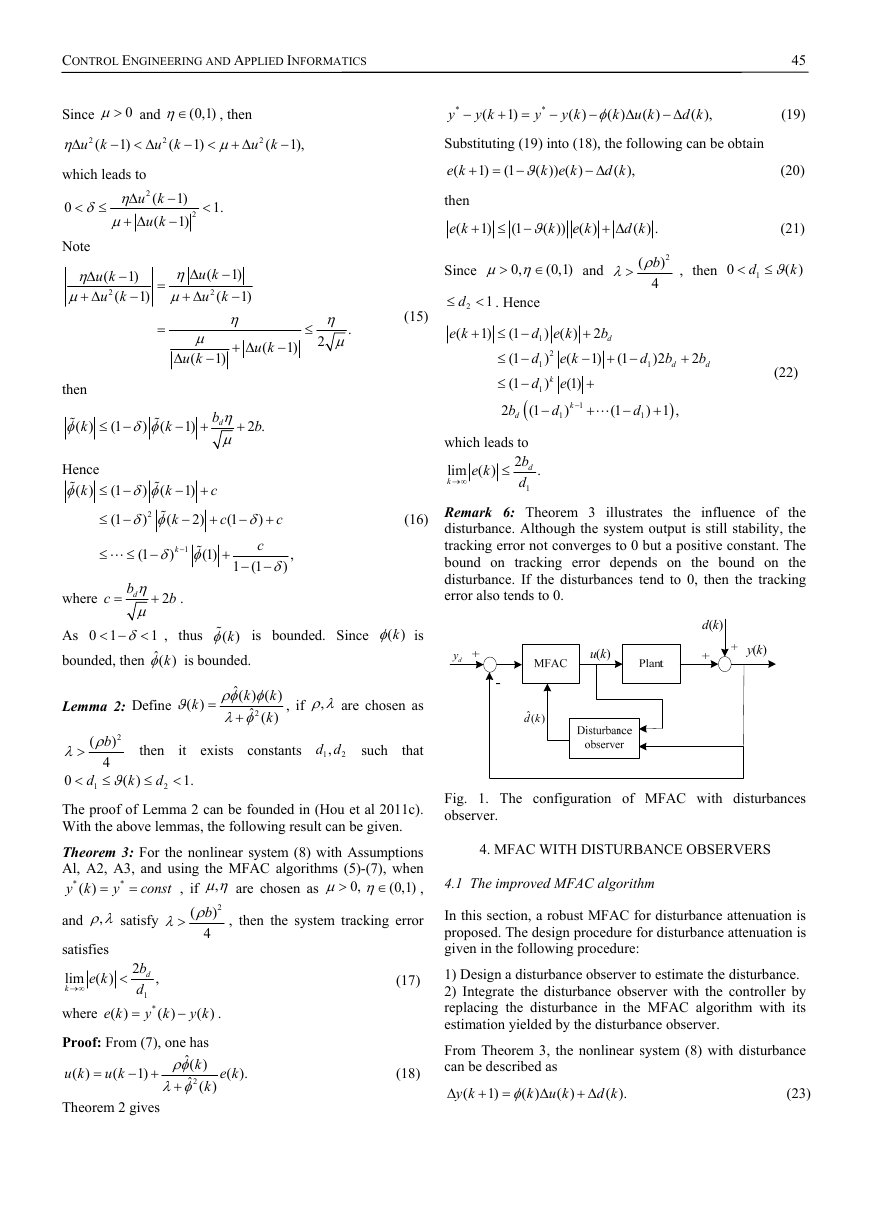
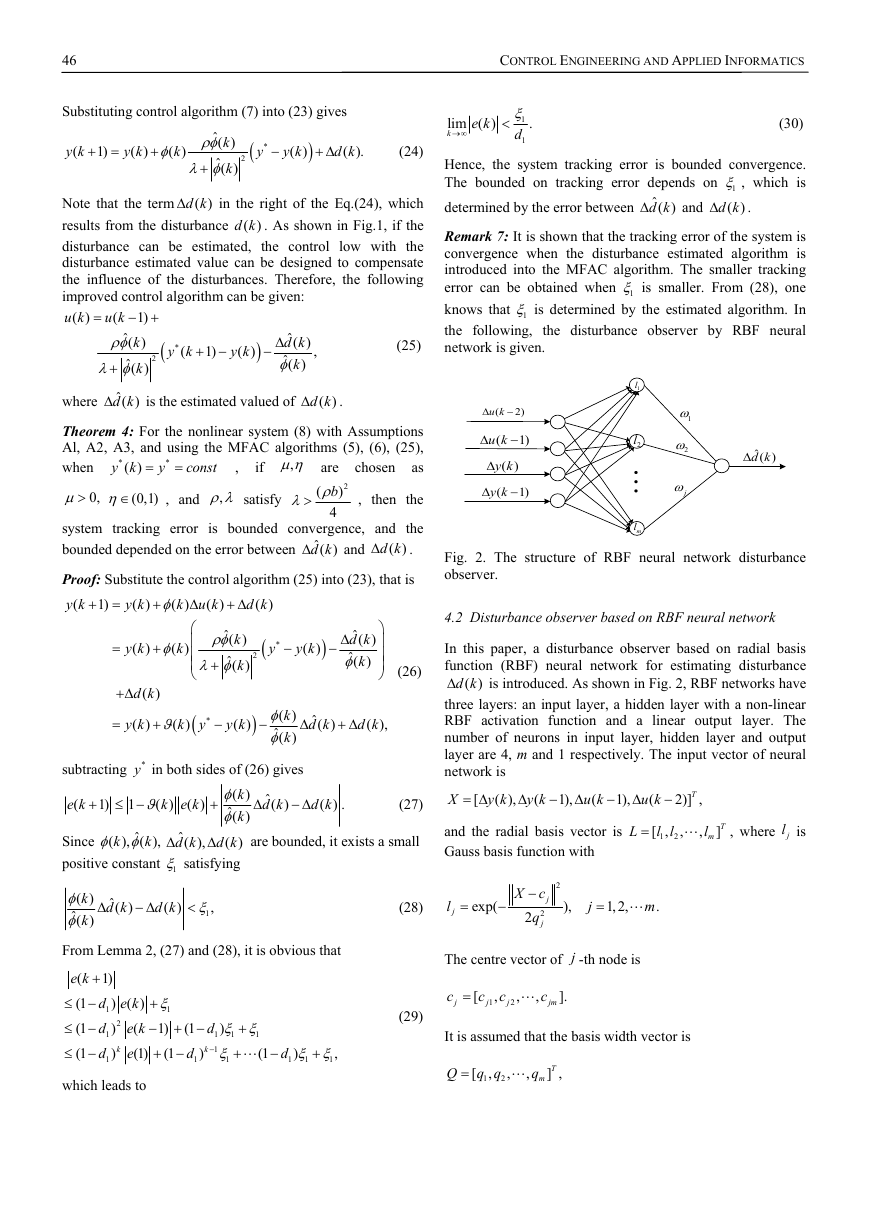
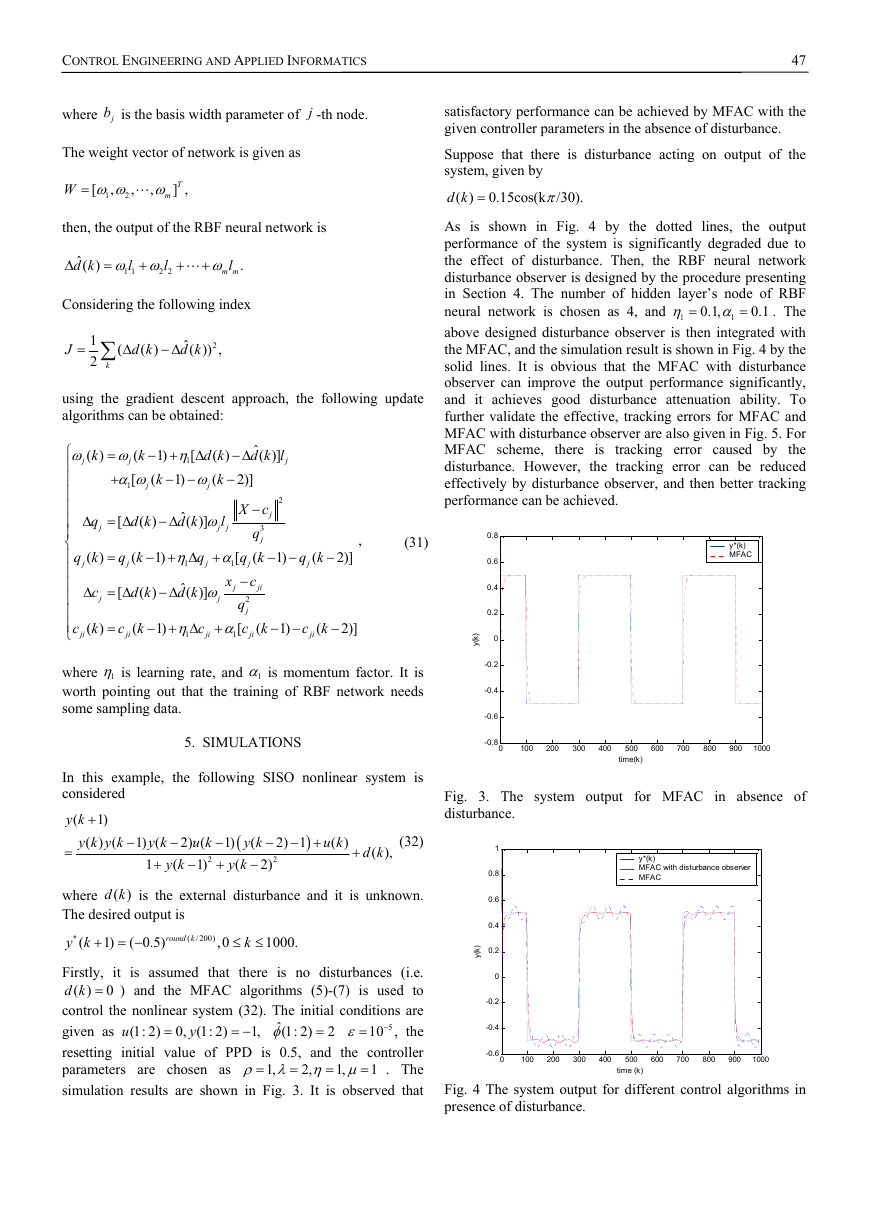










 2023年江西萍乡中考道德与法治真题及答案.doc
2023年江西萍乡中考道德与法治真题及答案.doc 2012年重庆南川中考生物真题及答案.doc
2012年重庆南川中考生物真题及答案.doc 2013年江西师范大学地理学综合及文艺理论基础考研真题.doc
2013年江西师范大学地理学综合及文艺理论基础考研真题.doc 2020年四川甘孜小升初语文真题及答案I卷.doc
2020年四川甘孜小升初语文真题及答案I卷.doc 2020年注册岩土工程师专业基础考试真题及答案.doc
2020年注册岩土工程师专业基础考试真题及答案.doc 2023-2024学年福建省厦门市九年级上学期数学月考试题及答案.doc
2023-2024学年福建省厦门市九年级上学期数学月考试题及答案.doc 2021-2022学年辽宁省沈阳市大东区九年级上学期语文期末试题及答案.doc
2021-2022学年辽宁省沈阳市大东区九年级上学期语文期末试题及答案.doc 2022-2023学年北京东城区初三第一学期物理期末试卷及答案.doc
2022-2023学年北京东城区初三第一学期物理期末试卷及答案.doc 2018上半年江西教师资格初中地理学科知识与教学能力真题及答案.doc
2018上半年江西教师资格初中地理学科知识与教学能力真题及答案.doc 2012年河北国家公务员申论考试真题及答案-省级.doc
2012年河北国家公务员申论考试真题及答案-省级.doc 2020-2021学年江苏省扬州市江都区邵樊片九年级上学期数学第一次质量检测试题及答案.doc
2020-2021学年江苏省扬州市江都区邵樊片九年级上学期数学第一次质量检测试题及答案.doc 2022下半年黑龙江教师资格证中学综合素质真题及答案.doc
2022下半年黑龙江教师资格证中学综合素质真题及答案.doc